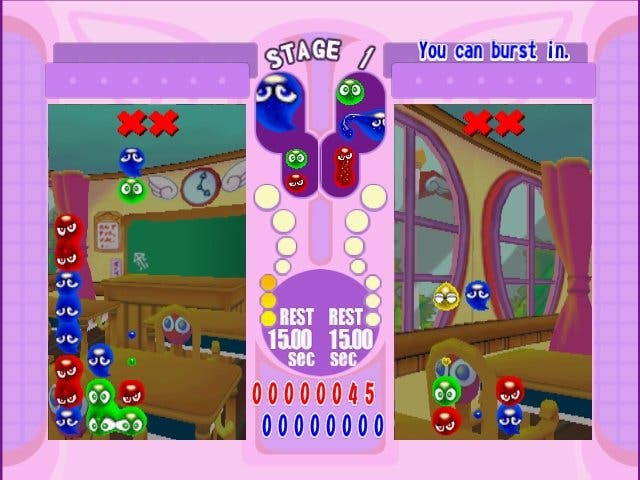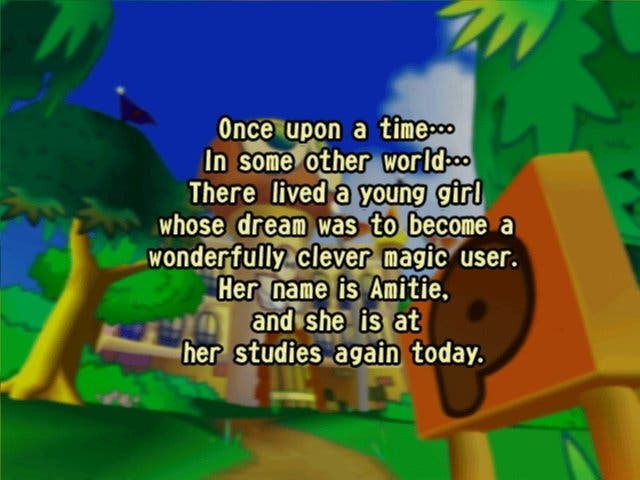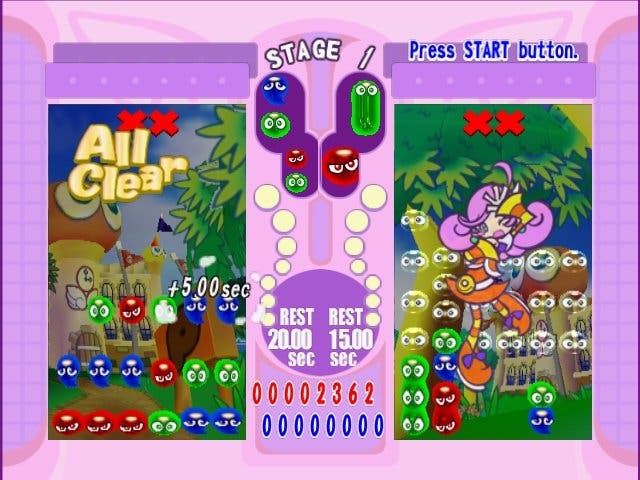Puyo Pop Fever
Dr. Romugwum's Mean Review Machine spits out another example. Puzzling.
Yikes, I thought. In these days of forty-hour role-playing games, Hollywood voice acting talent and running along the walls of sepia-tinted Persian fantasies, puzzle games are bound to be a hard sell. What am I going to do? Who wants to hear about connecting blobs and managing chain reactions in these days of acrobatic exploration and brutal combat, where the boundaries of the universe and the flow of time are variables rather than limitations, and there are epic tales of life, love, human tragedy and even alien tragedy to explore?
Fortunately, after a solid day of Puyo Pop Fever it all came flooding back. Very few genres offer as much accessibility and depth in both single and multiplayer modes as puzzle games, and very few puzzle games offer as much accessibility, depth, multiplayer entertainment and successful variation on the central theme as Sega's latest multi-platform blob-'em-up.
Pop Idol

If the screenshots look familiar, that's because Puyo Pop has been around in various incarnations for years and years. The first time I encountered it was actually under the banner of Kirby's Avalanche on the SNES - basically a re-badged Super Puyo Puyo released with revamped visuals in the USA in order to give it a recognition factor - but you may also have played it on the Neo Geo Pocket Colour, the N-Gage, the Mega-Drive, various Game Boys, the Dreamcast, and plenty more besides.
For better or worse, it's still largely the same game. For the most part it's played with two players, at least one human controlled, each trying to form "chains" by rotating and slotting pairs of different coloured blobs into groups of four or more of the same colour as they fall from the top of the screen. Doing so makes said blob groups disappear and dumps "nuisance" blobs on the other player's screen to upset their efforts. The first person to run out of space loses, either thanks to their opponent's skill in conjuring chain reactions to fuel larger nuisance dumps, or through their own lack of skill in managing the blobs' accelerating descent. Chains reactions, by the way, are when one set of blobs disappears allowing those above to join with those below and set off another chain, and mastering chain reactions is absolutely critical to success.
This alone makes for a highly entertaining, challenging and chaotic puzzle game, and for the tactically minded it's a glorious way of testing your mental reflexes, with plenty of highs along the way. Whether it's the first time you successfully plan and execute a three-layer chain reaction, the fiftieth time you struggle back from the jaws of defeat - complete with frantic "you're about to lose!" music - and grab victory, or the five-hundredth time you manage to topple an opponent's meticulous planning with one particularly well-timed chain and leave them powerless to fight back, it always has the power to fuel a broad grin and maybe even a yelp of excitement.
Mean Beans

But Puyo Pop Fever obviously has more to it than just vanilla Puyo Pop. For a start there's the eponymous Fever mode. This basically consists of a sort of power meter that fills up as you build more and more chains - a process accelerated by the use of larger chain reactions - until you're flipped into a sequence of pre-arranged screens and tasked with slotting the blobs raining down into the optimum position to create as many linked chains as possible. Doing so visits even more misery upon your rattled opponent and, with a bit of quick thinking, can be more than enough to conquer him outright.
Fortunately there are ways to deflect incoming attacks. Nuisance blocks won't fall until you fail to make a chain, and with each successful chain you neutralise a small amount of incoming nuisance, so theoretically a well-organised player can absorb plenty of punishment just by keeping a few readymade chains on the back burner to help him or her through troubled times. That's the theory anyway - in practice you'll need ninja wits, razor sharp reactions and a healthy dollop of luck if you want to stave off a Fevered attack completely.
There are other factors to consider too, like your anime Puyo avatar's unique blob sequence, which the insanely gifted can probably memorise from the character select screen and use to their advantage; and whether your flatmates are the sort of people to accept your screaming bloody murder every time they do anything to a degree of success and cause you a problem. Fortunately mine are well trained. Or at least well prepared.
Puyo, meet Puyo

However the presence of flatmates, siblings, wives, husbands, au pairs, pets, or possibly some manner of stranger off the street is another vital component, because unlike - say - Tetris, single-player Puyo Pop Fever is rather boring. The AI opponents are erratic adversaries, often riding you hard into the ground only to come completely unstuck with embarrassing haste on a second attempt. And while there are multiple play modes to explore, including a Mission mode that tasks you with completing quick-fire objectives against the clock, like linking two chains or making two different sets of coloured blobs disappear simultaneously, it won't take long before you tire of the process.
You can just play it like Tetris, building up four-blob sequences until your high score straddles the heavens and blobs are raining down at speeds that ought to dent the bottom of the TV, but it doesn't have that same endless charm and replayability in single-player as the classic Russian puzzler. The music isn't as good either.
In fact, the presentation while quirkily Japanese is little more than a passing novelty. The "cut sequences" that pop up between rounds in the main single-player mode quickly become utterly tedious once you've finished laughing at the little girl who wants to become a "wonderful magic user" (and judging by her clothes is already well into those wonderful magic mushrooms), and the soundtrack goes from passable to annoying to deeply and brain-sawingly tedious within the space of the first hour. The way the screen sweeps into a 3D display to highlight chain reactions can be a little unsettling too - fortunately the developer had the forethought to include toggles for virtually everything, albeit in the options menu rather than via the game screen itself. And, to be honest, you're going to have a hard time convincing me that the frog, Amitie and various other characters don't raise a smile as they yelp at each other's antics.
And of course very few of the game's issues matter if you've got a friend who's up for playing with you round after round after round. "Best of 50" would make for an exhaustingly entertaining evening, and although there's no four-player mode, even on the Cube and Xbox (come on Sega, would it hurt to try?), a small group of people and a "winner stays on" mandate would do well given a few beers and pizzas strewn over the coffee table. With various rule sets to try, including original pre-Fever mode, you're bound to find one everybody can agree on.
Hot and bothered
The question then is whether Puyo Pop Fever is better than the legions of other multiplayer games available on the current crop of consoles, and the answer is that it compares very favourably. I can remember spending much more time playing Bomberman with my friends than Kirby's Avalanche back in the day, but given that Fever is available for as little as £14.99 I have no trouble at all in recommending it. If only it had a single-player mode to match the blinding multiplayer experience, it could even justify a further point. As it is though, it's an excellent multiplayer title and that's more than enough at the price.








